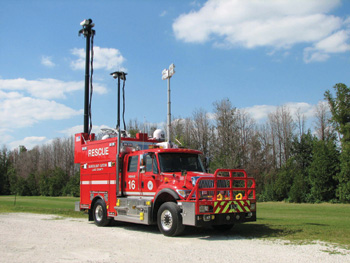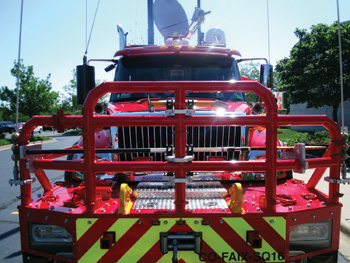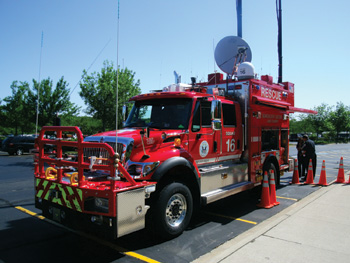Chris Mc Loone
Squad 16 is a specialized vehicle constructed by Alexis Fire Equipment and operating out of Colorado and Illinois that provides mobile emergency communications and disaster relief assistance and education to the public solely in conjunction with federal, state, and local government public safety and emergency management authorities. The unit responds to all incidents and all hazards including, but not limited to, designated national special security events, wildland fires, ice storms, and search and rescue missions. The vehicle recently operated at the Republican National Convention and assisted with the Hurricane Isaac response.
Origin
The idea for the unit originated more than 25 years ago as a result of the damage caused by a tornado, which eliminated all telecommunications and electric power distribution. Today, the unit functions under requests for deployments from an incident command staff. Recent duties have included acting as a forward operating post to assist paramedic dispatch at a designated national special security event; providing a radio bridge between a command post and a 75,000-acre-plus fireline, which was 25 miles away; and providing mobile radio, Internet, and telecom during an inbound convoy of 90 vehicles traveling more than 200 miles from a state’s capital to an incident site.
 |
| (1) Squad 16 provides mobile emergency communications and disaster relief assistance and education to the public solely in conjunction with federal, state, and local government public safety and emergency management authorities. (Photo courtesy of Squad 16.) |
The Rig
Accomplishing these tasks and providing these capabilities require a highly customized vehicle. The primary vehicle deployed by Squad 16 uses an International Trucks Severe Service 7400 4×4 crew cab chassis with a DT570 diesel engine, a drive train rated at 80,000 pounds, and a gross vehicle weight rating (GVRW) of 37,500 pounds. It has a 30-kW hydraulic generator and a redundant 12-kW diesel generator, both of which operate while driving, permitting communication operations while underway approximately two miles after initial startup.
The truck produces more than 15,000 watts of scene lighting, and with 185 gallons of diesel fuel it can operate for more than 16 days without refueling. The vehicle’s specialized design and wide front axle permit it to have a turning radius smaller than its overall length of 29 feet, four inches. Because it has more than 10,000 pounds of equipment mounted under the top of its double-reinforced chassis frame rails, Squad 16 has a relatively low center of gravity of less than 40 percent of its 12-foot, nine-inch height. The maximum allowable, according to National Fire Protection Association (NFPA) 1901, Standard for Automotive Fire Apparatus, is 80 percent, and the unit also exceeds NFPA 1901’s horizontal tilt test of 26.5 degrees.
It has a full array of electrical equipment in its more than 24 feet of vertical rack space including a multipath telecom IP system with a 1.2-meter VSAT, a 25-watt BUC, two Iridiums, two Telulars, one router, two switches, eight wall phones, six wireless VoIP phones, three servers, one spectrum analyzer, and three double conversion uninterrupted power supplies.
Radio operations and interoperability are provided by two redundant systems (Raytheon ACU-2000 IP and ClearCom); more than 40 radios; two repeaters; an 80-position antenna-radio patch panel; and an array of more than 70 redundant antennas mounted on the 11-foot roof, the 30-foot mast, and the 50-foot mast.
 |
| (2) Squad 16 has a 2,000-pound ¾-inch steel plate front bumper assembly that has two receivers for a 10,000-pound (1,000-pound workable load) 120-VAC electric rope rescue Amkus winch. In addition, the front bumper assembly has a 16,500-pound 12-VDC electric steel cable Warn winch and two primary tow hooks rated at 30,000 pounds each. (Photo by author.) |
Stability and leveling for SAT acquisitions are provided by four hydraulic stabilization jacks. Three air conditioning units with a total of more than 40,000 Btus provide cooling for the stainless steel walk-in communications center, which is accessed via an aft door. This communications center can also serve as an emergency cooling center for anyone suffering from heat stress such as civilians, firefighters, rescue teams, or other public safety personnel.
Specialized equipment mounted on top of the 50-foot pneumatic mast includes a primary rescue searchlight, which projects usable light approximately 1.5 miles downrange, mounted alongside two long-range day/night (0.07-lux) cameras, which have a detection range of four miles, recognition at two miles, and identification at one mile. The searchlight can also be operated at vehicle speeds up to 10 miles per hour (mph) with the mast deployed to a height of 15 feet. In addition to white visible light, an automatic filter wheel can provide multiple frequencies and colors, including amber (550 nanometers) to cut through smoke, red (680 nanometers) for night vision, and infrared (880 nanometers) for those incidents where ground personnel are wearing night vision goggles or a helicopter flight crew requests an infrared illuminated landing zone.
Two redundant scene lighting systems include a 120-VAC 6,000-watt light tower mounted on the crew cab roof with a 20-foot elevation, four 12-VDC 1,500-watt floodlights, and three 12-VDC remote-controlled crew cab roof searchlights.
During both day and night operations with restricted views because of fog or smoke, a forward looking infrared (FLIR) camera provides the engineer and officer with improved visibility and allows them to see heat signatures including, but not limited to, a victim.
The unit and personnel can also assist with rescue operations. Squad 16 has a 2,000-pound ¾-inch steel plate front bumper assembly that has two receivers for a 10,000-pound (1,000-pound workable load) 120-VAC electric rope rescue Amkus winch. In addition, the front bumper assembly has a 16,500-pound 12-VDC electric steel cable Warn winch and two primary tow hooks rated at 30,000 pounds each. Rigging includes four adjustable poles that permit an angle of attack up to approximately 12 feet above the ground. Tow chains, webbing, extrication tools, and saws can also be used with the two winches to clear fallen trees or debris that block the roadway.
If requested, a live video feed from the forward-facing camera to a secure Web site can provide a real-time view of both the roadway conditions and the rate of progress for a convoy. Once on station, mast-mounted cameras on both the 30- and 50-foot masts can provide an overview of the scene and also a view of down-range operations.
 |
| (3) Squad 16 personnel were very specific about what they wanted from the truck. As a result, Alexis Fire Equipment, the truck manufacturer, prepared more than 30 blueprints, provided numerous engineering revisions, and still met all its deadlines. (Photo by author.) |
Building the Rig
Building a unit as specialized as Squad 16 requires a lot of customization. To build the truck, the unit contracted with Alexis Fire Equipment. “One of the biggest challenges was designing the unit so all the desired equipment would fit into the limited space available,” says Doug Gau, project manager with Alexis Fire Equipment. “Many of the brackets and attachments are custom-designed to meet the specific needs of each piece of equipment mounted on the vehicle. The original design and intended use of the vehicle evolved during each phase of modifications.”
The personnel at Squad 16 were very specific about what they wanted on the truck and how they wanted it built. As a result, Alexis prepared more than 30 blueprints, provided numerous engineering revisions, and still met all its deadlines. These special requests also provided Alexis with a variety of features that it has incorporated into subsequent units it has built. “We have not currently manufactured any other units like Squad 16-it is a one-of-a-kind piece,” says Gau. “We have, however, incorporated many of the features on that unit into other emergency vehicles we have manufactured. The knowledge and experience gained from manufacturing the unit have provided us with a toolbox of unique features and benefits we can offer new truck customers.”
Gau says one of the keys to the success of the project-and this is a key in any apparatus built by any manufacturer-was the customer’s input. Squad 16 was very specific about what it wanted from the truck. “That knowledge, combined with our experience, helped us to design and manufacture the unit to completely meet the customer’s requirements,” Gau states. Additionally, the customer wanted only the best materials on the market used in the manufacture of the apparatus from the ground up. “These factors combined allowed us to build an apparatus that will be versatile, capable, and dependable for years to come,” Gau concludes.
CHRIS Mc LOONE, associate editor of Fire Apparatus & Emergency Equipment, is a 19-year veteran of the fire service and a captain with Weldon Fire Company (Glenside, PA). He has been a writer and editor for more than 15 years. While with Fire Engineering, he contributed to the May 2006 issue, a Jesse H. Neal Award winner for its coverage of the Hurricane Katrina response and recovery.

